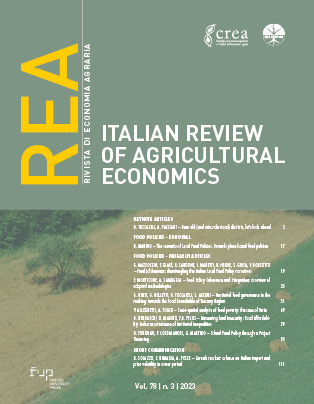Published 2024-04-03
Keywords
- cereal prices,
- cereal products,
- Italian imports,
- forecasting,
- Black Sea Grain Initiative
How to Cite
Copyright (c) 2023 Roberto Solazzo, Federica DeMaria, Alessandra Pesce

This work is licensed under a Creative Commons Attribution 4.0 International License.
Abstract
The conflict between Ukraine and Russia raises several questions and uncertainty about the cereal supply chain and market trends. This international crisis and other factors influencing the market, such as the environmental and climate ones, have placed greater attention on Italy’s dependence on foreign countries for some important products for our agri-food industry, including cereals and feed for the livestock sector. The Italian pasta industry, as well as bakery products, need a constant and large supply of wheat, which often comes from foreign markets. This also applies to the livestock sector, with relevant imports of raw materials from abroad for the feed sector. International events also affected Italian cereal imports, although Italy does not strongly depend on the Black Sea for these products. This article provides an analysis of the Italian import of cereals in the recent period when market instability linked to the conflict and other factors emerged. The study also focuses on the forecast for the future and on the role of price dynamics.
Downloads
References
- AMIS (2023). AMIS Market Monitor No.10 July 2023. Available at https://www.amis-outlook.org/index.php?id=48514
- Arzeni A., Cesaro L., Giampaolo A., Martino M., Pesce A., Scardera A., Zilli G., Vaccari S. (2022). Guerra in Ucraina: gli effetti sui costi e sui risultati economici delle aziende agricole italiane. CREA-PB, RICA.
- Baffes J., Haniotis T. (2010). Placing the 2006/2008 Commodity Price Boom into Perspective. World Bank Policy Research Working Paper No. 5371.
- Behnassi M., El Haiba M. (2022). Implications of the Russia-Ukraine war for global food security. Nat Hum Behav, 6: 754-755. DOI: https://doi.org/10.1038/s41562-022-01391-x.
- EC (2023). Short-term outlook for EU agricultural markets, Spring 2023. European Commission, DG Agriculture and Rural Development, Brussels.
- Fang Y., Shao Z. (2022). The Russia-Ukraine conflict and volatility risk of commodity markets. Finance Research Letters, 50, 103264. DOI: https://doi.org/10.1016/j.frl.2022.103264.
- FAO (2022). The importance of Ukraine and the Russian Federation for Global Agricultural Markets and the Risk associated with the War in Ukraine, 10 June 2022 Update.
- Haile M.G., Kalkuhl M., von Braun J. (2015). Worldwide acreage and yield response to international price change and volatility: A dynamic panel data analysis for wheat, rice, corn, and soybeans. American Journal of Agricultural Economics, 98: 172-190. DOI: https://doi.org/10.1093/ajae/aav013.
- Hebebrand C., Laborde D. (2022). High Fertilizer Prices Contribute to Rising Global Food Security Concerns International Food Policy Research Institute, Washington D.C.
- IEA (2023). Imports/Exports. Available at https://www.iea.org/data-and-statistics.
- IGC (2023). Grain Market Report. Available at https://www.igc.int/en/gmr_summary.aspx
- IMF (2022). World Economic Outlook: Countering the Cost-of-Living Crisis. Washington, DC.
- Jumah A., Kunst R.M. (2008). Seasonal prediction of European cereal prices: good forecasts using bad models?. Journal of Forecasting, 27(5): 391-406. DOI: https://doi.org/10.1002/for.1062.
- Karali B., Irwin S.H., Isengildina-Massa O. (2020). Supply fundamentals and grain futures price movements. American Journal of Agricultural Economics, 102(2): 548-568. DOI: https://doi.org/10.1002/ajae.12012.
- Kwas M., Paccagnini A., Rubaszek M. (2022). Common factors and the dynamics of cereal prices. A forecasting perspective. Journal of Commodity Markets, 28, 100240. DOI: https://doi.org/10.1016/j.jcomm.2021.100240.
- Ljungqvist F.C., Thejll P., Christiansen B., Seim A.C., Esper J. (2022). The significance of climate variability on early modern European grain prices. Cliometrica, 16(1): 29-77. DOI: https://doi.org/10.1007/s11698-021-00224-7.
- Mottaleb A.K., Kruseman G., Snapp S. (2022). Potential impacts of Ukraine-Russia armed conflict on global wheat food security: A quantitative exploration. Global Food Security, 35, 100659. DOI: https://doi.org/10.1016/j.gfs.2022.100659.
- OECD (2022). The impacts and policy implications of Russia’s aggression against Ukraine on agricultural markets. OCED Policy Response, August 2022.
- OECD-FAO (2022). OECD-FAO Agricultural Outlook 2022-2031. OECD Publishing, Paris. DOI: https://doi.org/10.1787/f1b0b29c-en.
- Santeramo F.G., Lamonaca E., Contò F., Nardone G., Stasi A. (2018). Drivers of grain price volatility: a cursory critical review. Agricultural Economics – Czech., 64(8): 347-356. DOI: 10.17221/55/2017-AGRICECON.
- Steen M., Bergland O., Gjølberg O. (2023). Climate Change and Grain Price Volatility. Empirical Evidence for Corn and Wheat 1971-2019. Commodities, 2: 1-12. DOI: https://doi.org/10.3390/commodities2010001.
- UNCTAD (2022). Global impact of war in Ukraine on food, energy and finance systems.
- USDA (2023) Russia Grain and Oilseed Exports Expand. Report May 8, 2023. International Agricultural Trade Report.
- World Bank (2022). The Impact of the War in Ukraine on Commodity Markets. Commodity Markets Outlook, April 2022.
- World Bank (2023). Food Security Update. World Bank Report. LXXXIX, July 13, 2023.


